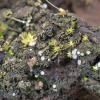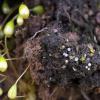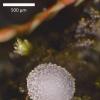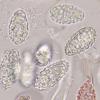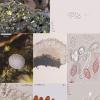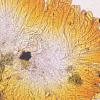
15-12-2025 15:48
 Danny Newman
Danny Newman
Melanospora cf. lagenaria on old, rotting, fallen

15-12-2025 15:54
 Johan Boonefaes
Johan Boonefaes
Unknown anamorph found on the ground in coastal sa

15-12-2025 21:11
 Hardware Tony
Hardware Tony
Small clavate hairs, negative croziers and IKI bb

15-12-2025 07:09
 Danny Newman
Danny Newman
indet. Rutstroemiaceae sp. on unk. fallen leavesMc

15-12-2025 07:05
 Danny Newman
Danny Newman
Pseudosclerococcum golindoi (det: Zotto)near Cosb

15-12-2025 11:49
 Danny Newman
Danny Newman
ITS sequences from the following two collections B

15-12-2025 12:34
 Danny Newman
Danny Newman
indet. Rhytismataceae on oak leafnear Purchase Roa

09-12-2025 12:06
 Andgelo Mombert
Andgelo Mombert
Bonjour,Je recherche l'article concernant Hypobryo
White ascolichen (?) on burnt ground
Enrique Rubio,
18-03-2019 12:06
These minute, white, sessile, pruinose, hemisphaerical, neither applanate nor cupulate, 0.5-0.7 mm in diameter, grew among Ceratodon purpureus and algae on sandy burnt soil.
The thick-walled, strongly dextrinoid asci which may appear to be bitunicate, have an irregular apical dehiscence as in some Mniaeceia species (white arrow). No conspicuous paraphyses I have seen. Ascospores coarsely verrucose.
Some idea for it?
Many thanks again
Enrique
Hans-Otto Baral,
18-03-2019 12:16

Re : White ascolichen (?) on burnt ground
Hi Enrique
superb. The asci are hemiamyloid, not dextrinoid, and I am quite sure this belongs in Vezdaea. No idea about a name, I have no key at hand.
Zotto
superb. The asci are hemiamyloid, not dextrinoid, and I am quite sure this belongs in Vezdaea. No idea about a name, I have no key at hand.
Zotto
Enrique Rubio,
18-03-2019 12:21
Re : White ascolichen (?) on burnt ground
Hi Zotto
Could you explain to me the differences between hemiamyloid and dextrinoid?
Could you explain to me the differences between hemiamyloid and dextrinoid?
Hans-Otto Baral,
18-03-2019 12:27

Re : White ascolichen (?) on burnt ground
This is quite easy:
dextrinoid is a red reaction that is seen in both Lugol and Melzer (better in the latter), and if you pretreat with KOH it is still red.
hemiamyloid is only red in Lugol, and if you KOH-pretreat, the reaction is blue.
In your Vezdaea surely the asci will react blue after KOH.
Besides, I never met an ascus with an outer wall reacting dextrinoid.
Zotto
dextrinoid is a red reaction that is seen in both Lugol and Melzer (better in the latter), and if you pretreat with KOH it is still red.
hemiamyloid is only red in Lugol, and if you KOH-pretreat, the reaction is blue.
In your Vezdaea surely the asci will react blue after KOH.
Besides, I never met an ascus with an outer wall reacting dextrinoid.
Zotto
Enrique Rubio,
18-03-2019 12:43
Hans-Otto Baral,
18-03-2019 12:50

Re : White ascolichen (?) on burnt ground
Did you also test MLZ for whether the red appears?
Enrique Rubio,
18-03-2019 13:08
Antonio Gómez-Bolea,
18-03-2019 14:48
Re : White ascolichen (?) on burnt ground
Yes is Vezdaea
V. rheocarpa fits well with your sample.
Hans-Otto Baral,
18-03-2019 15:25

Re : White ascolichen (?) on burnt ground
I suppose your first KOH-pretreatment was not strong enough. In the second I see only blue ascus walls. Higher KOH-concentrations or a short heating over a flame assure that the chemical conversion takes place.
MLZ without KOH should be negative, I think the orange is due to plasma staining by the colour of iodine.
MLZ without KOH should be negative, I think the orange is due to plasma staining by the colour of iodine.
Enrique Rubio,
18-03-2019 15:48
Re : White ascolichen (?) on burnt ground
Thanks, Zotto and Antonio.
I will look for V. rheocarpa.
I will look for V. rheocarpa.
Enrique Rubio,
18-03-2019 16:12
Re : White ascolichen (?) on burnt ground
By the way
Has someone the invalid description of Vezdaea rheocarpa Poelt & Döbbeler, Bot. Jb. 96(1-4): 347 (1975)?
Many thanks in advance
enrirubio@asturnatura.com
Has someone the invalid description of Vezdaea rheocarpa Poelt & Döbbeler, Bot. Jb. 96(1-4): 347 (1975)?
Many thanks in advance
enrirubio@asturnatura.com
